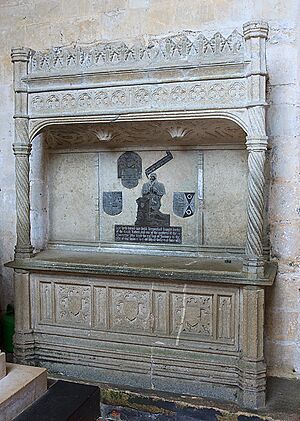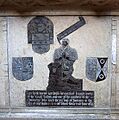John Tregonwell facts for kids
Sir John Tregonwell (died 1565) was an important lawyer from Cornwall, England. He worked closely with King Henry VIII and his chief minister, Thomas Cromwell. Sir John played a big role in the Dissolution of the Monasteries, which was when the King closed down many monasteries and took their lands. He also served as a judge in the Admiralty Court, which handled legal cases related to the sea, from 1524 to 1536.
Contents
Early Life and Education
John Tregonwell was born in Cornwall. He was the second son in his family. He went to Oxford University, starting at a place called Broadgates Hall. He studied law and earned his Bachelor of Civil Law degree in 1516. A few years later, in 1522, he received his Doctor of Civil Law degree. Before he left Oxford, he became the head of another hall, Vine Hall. Around 1524, he was appointed as a judge in the Admiralty Courts.
A Career in Royal Service
Sir John Tregonwell had a very busy career working for the King.
Early Legal and Diplomatic Work
In 1527, he was part of a group tasked with investigating and punishing serious crimes at sea, like treason and piracy. He also helped in official visits to monasteries, such as Thetford Priory, to check on how they were being run.
In 1532, he was involved in important talks with officials from the Netherlands. These discussions aimed to solve disagreements between merchants from England and Flanders (part of modern-day Belgium). He was known as a "Doctor of Laws" and a "Judge of the High Court of Admiralty," showing his important position in legal matters concerning the sea.
Role in King Henry VIII's Affairs
Sir John Tregonwell became very important when Thomas Cranmer was made Archbishop of Canterbury in 1533. Tregonwell quickly became a key figure in state affairs. He was one of the witnesses when Archbishop Cranmer made a private statement before his official appointment.
He also played a crucial part in King Henry VIII's divorce from Catherine of Aragon. In 1533, he represented the King in a special meeting of church leaders, asking them to put their decisions about the divorce in writing. He was present when Archbishop Cranmer declared the King's marriage dissolved. After this, Tregonwell was given a yearly payment of £40 for the rest of his life.
He helped sign peace treaties with Scotland in 1534 on behalf of King Henry. He was also involved in legal actions against important figures like Thomas More and Anne Boleyn. By 1536, he became a "Master in Chancery," which meant he was a senior legal official.
The Dissolution of the Monasteries
Sir John Tregonwell's most significant work was his role in the Dissolution of the Monasteries. This was a major event where King Henry VIII closed down monasteries across England. Tregonwell's main job was to oversee the surrender of these monasteries to the King.
His letters show that he was more fair than some other officials involved in this process. He mostly worked in the south and west of England. He also helped question people involved in the Pilgrimage of Grace, which was a large rebellion against the King's religious changes. He was so trusted that Thomas Cromwell even considered him for a very high legal position. He continued to hold important legal roles, including Chancellor of Wells Cathedral and a commissioner for the Great Seal.
Later Life and Recognition
When Queen Mary I came to the throne in 1553, she reversed many of her father's religious policies. Sir John Tregonwell was appointed to a group of judges who looked into the case of Edmund Bonner, who had been removed as Bishop of London. Tregonwell ruled in Bonner's favor, allowing him to return to his position. This was a big moment in Queen Mary's plan to bring back Catholic practices.
Sir John Tregonwell was knighted on October 2, 1553, which meant he was given the title "Sir." He also became a Member of Parliament for Scarborough in 1553.
Death and Burial
Sir John Tregonwell passed away on January 8 or 13, 1565. He died at Milton Abbas, a place he had bought after the monasteries were dissolved. His will, which is a legal document about his property, was approved in May 1565.
His Monument
Sir John Tregonwell was buried in the beautiful Milton Abbey church. His tomb is a large stone monument with a carved chest and a canopy above it. The monument has special metal plates with pictures and writing. One plate shows Sir John kneeling and praying, wearing armor. Another plate has an inscription that says: "Here lies buried Sir John Tregonwell, knight, doctor of the Civil Laws, and one of the masters of the Chancery, who died the 13th day of January in the year of our Lord 1565. May God have mercy on his soul."
Other plates on the tomb show his family's coats of arms, which are special symbols representing his family and the families of his wives.
Family Life
Sir John Tregonwell was married twice.
His first wife was an heiress named Newce from Oxfordshire. They had children:
- Thomas Tregonwell, who married twice. He died before his father, so his son, also named John Tregonwell, inherited Sir John's property.
- Anne Tregonwell, who married Richard Reade, who became the Lord Chancellor of Ireland.
- Mary Tregonwell, who married a member of the De la Lynde family.
Sir John's second wife was Elizabeth Kellaway. She was the daughter of Sir John Kellaway. When she married Tregonwell in 1549, she was already a widow with nine children from her first marriage to Robert Martyn. Sir John and Elizabeth did not have any children together.
Family Challenges
After Sir John Tregonwell died, there was a disagreement between his widow, Elizabeth, and his step-grandson, John Tregonwell (the son of Thomas). This dispute involved property.
Elizabeth Tregonwell was later investigated because she was helping a young Roman Catholic named Thomas Sherwood. This was a problem because, at the time, people were expected to follow the Church of England. Elizabeth was questioned in 1580 but was not severely punished. It's interesting because her husband, Sir John, had been a key figure in closing down monasteries and changing the religious landscape of England, while his widow faced issues for her Catholic beliefs. Elizabeth Tregonwell made her will in 1576 and it was approved in 1584.
Images for kids



